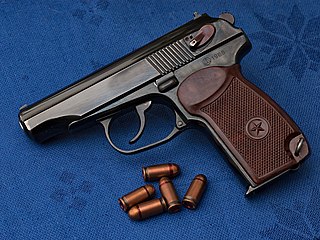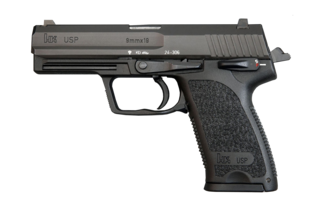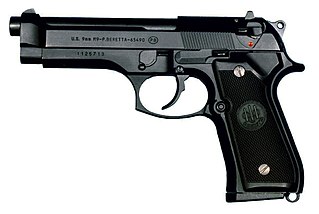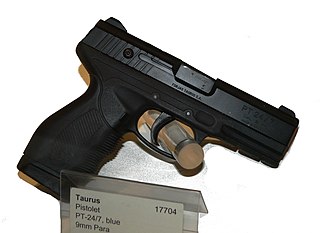Related Research Articles

Gun safety is the study and practice of using, transporting, storing and disposing of firearms and ammunition, including the training of gun users, the design of weapons, and formal and informal regulation of gun production, distribution, and usage, for the purpose of avoiding unintentional injury, illness, or death. This includes mishaps like accidental discharge, negligent discharge, and firearm malfunctions, as well as secondary risks like hearing loss, lead poisoning from bullets, and pollution from other hazardous materials in propellants and cartridges. There were 47,000 unintentional firearm deaths worldwide in 2013.

In firearms terminology, an action is the functional mechanism of a breech-loading firearm that handles the ammunition cartridges, or the method by which that mechanism works. Actions are technically not present on muzzleloaders, as all those are single-shot firearms with a closed off breech with the powder and projectile manually loaded from the muzzle. Instead, the muzzleloader ignition mechanism is referred to as the lock.

The Makarov pistol or PM is a Soviet semi-automatic pistol. Under the project leadership of Nikolay Fyodorovich Makarov, it became the Soviet Union's standard military and Militsiya side arm in 1951.

The Desert Eagle is a gas-operated, semi-automatic pistol known for chambering the .50 Action Express, the largest centerfire cartridge of any magazine-fed, self-loading pistol.

The CZ 52 is a semi-automatic pistol designed by two brothers, Jan and Jaroslav Kratochvíl, in the early 1950s for the Czechoslovak military. Around 200,000 vz. 52s were made by Česká Zbrojovka in Strakonice from 1952 to 1954. Before standardizing on the 7.62×25mm vz. 52, the Czechoslovak military used several domestic and foreign pistol models in three different calibers. After 30 years of military service, the vz. 52 was eventually replaced by the 9×18mm Makarov caliber vz. 82.

A magazine is an ammunition storage and feeding device for a repeating firearm, either integral within the gun or externally attached. The magazine functions by holding several cartridges within itself and sequentially pushing each one into a position where it may be readily loaded into the barrel chamber by the firearm's moving action. The detachable magazine is sometimes colloquially referred to as a "clip", although this is technically inaccurate since a clip is actually an accessory device used to help load ammunition into a magazine.

A firearm is said to fire from an open bolt if, when ready to fire, the bolt and working parts are held to the rear of the receiver, with no round in the chamber. When the trigger is actuated, the bolt travels forward, feeds a cartridge from the magazine or belt into the chamber, and fires that cartridge in the same movement. Like any other self-loading design, the action is cycled by the energy released from the propellant, which sends the bolt back to the rear, compressing the mainspring in readiness for firing the next round. In an open-bolt gun firing semi-automatically, the bolt is caught and held at this point by the sear after each shot; and in automatic open-bolt fire, it's caught and held in this manner whenever the trigger is released. In contrast to this, in closed-bolt guns, the trigger and sear do not affect the movement of the bolt directly.

The USP is a semi-automatic pistol developed in Germany by Heckler & Koch GmbH (H&K) as a replacement for the P7 series of handguns.

The Beretta M9, officially the Pistol, Semiautomatic, 9mm, M9, is the designation for the Beretta 92FS semi-automatic pistol used by the United States Armed Forces. The M9 was adopted by the United States military as their service pistol in 1985.

The Taurus PT 24/7 is a semi-automatic pistol using the short type of recoil operation, and available in various models with double-action-only (DAO) and double action/single-action-type trigger actions. Using a hammerless, striker-fired design, these pistols are manufactured by Forjas Taurus S/A in Porto Alegre Brazil and distributed in the United States by their subsidiary Taurus USA. The 24/7 product line was designed for the civilian concealed carry firearms market, and as backup weapons for law enforcement officers.

A trigger is a mechanism that actuates the function of a ranged weapon such as a firearm, airgun, crossbow, or speargun. The word may also be used to describe a switch that initiates the operation of other non-shooting devices such as a trap, a power tool, or a quick release. A small amount of energy applied to the trigger leads to the release of much more energy.

A snap cap is a firearm accessory device shaped like a standard cartridge/shotshell but contains no functional components, namely the primer, propellant (gunpowder) and projectile. It serves the same purpose as a dummy round, but different in that a dummy is usually modified from a real cartridge with its propellant and primer removed, while a snap cap has a monolithic outer shell and is specifically designed to be a fake cartridge from the very beginning.

Break action is a type of firearm action in which the barrel or barrels are hinged much like a door and rotate perpendicularly to the bore axis to expose the breech and allow loading and unloading of cartridges. A separate operation may be required for the cocking of a hammer to fire the new round. There are many types of break-action firearms; break actions are universal in double-barrelled shotguns, double-barrelled rifles, combination guns, and are commonly found in single shot pistols, rifles, shotguns, including flare guns, grenade launchers, air guns, and some older revolver designs. They are also known as hinge-action, break-open, break-barrel, break-top, or, on old revolvers, top-break actions.

A handgun is a firearm designed to be usable with only one hand. It is distinguished from a long gun which needs to be held by both hands and braced against the shoulder. The two most common types of handguns are revolvers and semi-automatic pistols, although other types such as derringers and machine pistols also see infrequent usage.
Forward assisting is the practice of moving the bolt or bolt carrier of a firearm fully forward when the return spring has not done so. Some firearms have a dedicated device to allow forward assisting; on others, it is simply a procedure performed on the charging handle.

Glock is a brand of polymer-framed, short recoil-operated, locked-breech semi-automatic pistols designed and produced by Austrian manufacturer Glock Ges.m.b.H.
A firearm malfunction is the failure of a firearm to operate as intended for causes other than user error. Malfunctions range from temporary and relatively safe situations, such as a casing that did not eject, to potentially dangerous occurrences that may permanently damage the gun and cause injury or death. Improper handling of certain types of malfunctions can be very dangerous. Following gun safety rules can prevent firearm malfunctions, and limit the damage inflicted by them if they do occur. Proper cleaning and maintenance of a firearm play a big role in preventing malfunctions.

Firearm maintenance is a series of routine preventive maintenance procedures aiming to ensure the proper function of a firearm, often with the use of a variety of specialized tools and chemical solutions. Typically such maintenance is performed by the firearm owner using either simple methods such as cleaning the firearm with oil or other cleaning solutions or more sophisticated practices such as lubricating moving parts with oil/grease and recoating exposed surfaces with protective finishes such as varnishing or bluing.

In firearms, a safety or safety catch is a mechanism used to help prevent the accidental discharge of a firearm, helping to ensure safer handling.

The FN FNS pistol is a series of striker-fired semi-automatic, polymer-framed pistols manufactured in Fredericksburg, Virginia, by FN America, a division of Fabrique Nationale Herstal. The pistol is chambered for the 9×19mm Parabellum and .40 S&W cartridges.
References
- ↑ Tong, David, "Trigger Options of the Semi-Automatic Service Pistol"
- 1 2 "When 'Tap, Rack, Bang' Doesn't Clear a Jam, Perform Remedial Action". Tactical-Life. June 14, 2019. Archived from the original on December 3, 2022. Retrieved August 30, 2020.
- ↑ Schley, Bill (2013-04-12). The UnStoppables: Tapping Your Entrepreneurial Power. John Wiley & Sons. ISBN 978-1-118-52621-7.
- ↑ Rementer, Stephen R.; Eimer, Bruce N. (2005). Essential Guide to Handguns: Firearm Instruction for Personal Defense and Protection. Looseleaf Law Publications. ISBN 978-1-889031-65-1.
- 1 2 "Perform Immediate Action to Get Your Jammed AR-15 Back in the Fight". Tactical Life. May 28, 2019. Archived from the original on October 1, 2022. Retrieved August 30, 2020.
- ↑ Immediate and Remedial Action - M9 Service Pistol, Marine Corp Development Command, p. 7, archived from the original on 2014-03-17, retrieved 2016-03-07
- ↑ "Firearms instructors offer advice on handling weapon malfunctions". ABC7: KLTV. February 28, 2013. Archived from the original on June 25, 2022. Retrieved 2020-08-30.